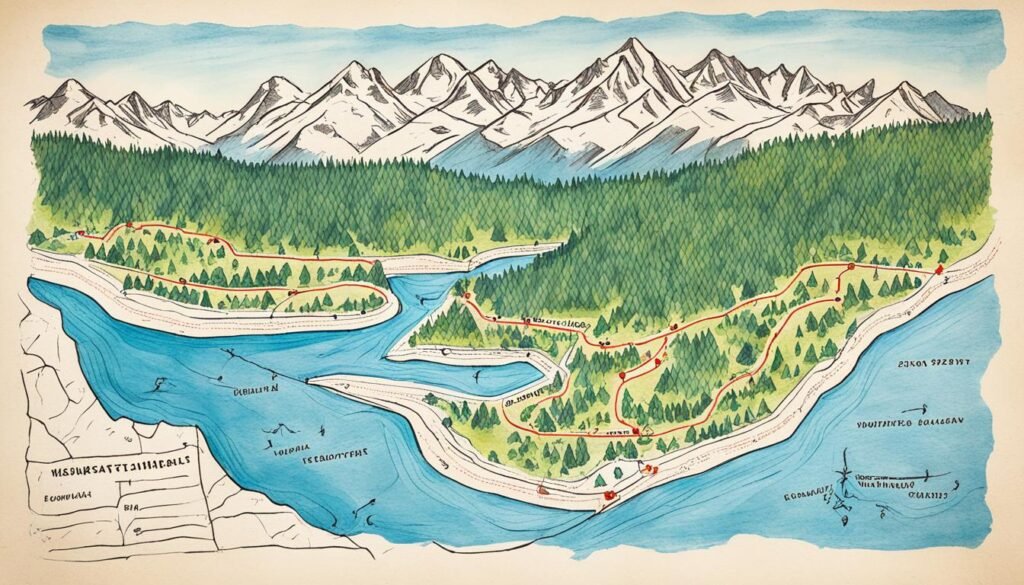Navigating without a map can be a daunting task, but with the right skills and techniques, it’s possible to find your way using only a compass. In this article, I will guide you through the art of compass navigation and share essential tips for navigating without a map in the great outdoors.
Key Takeaways
- Learn compass navigation techniques to navigate without a map.
- Develop essential compass navigation skills for outdoor exploration.
- Discover the art of orienteering with a compass in remote areas.
- Master compass navigation tips for accurate direction finding.
- Find your way with the help of a compass, even in unfamiliar territory.
The Basics of Compass Navigation
Before diving into compass navigation techniques, it’s crucial to understand the basic components of a compass and the difference between magnetic north and true north.
A compass consists of three main parts:
- The magnetic needle, which is a small magnet that aligns with the Earth’s magnetic field and always points toward magnetic north.
- The orienting arrow, which is used to align the compass with the map or the surrounding environment.
- The direction of travel arrow, which is a transparent arrow that rotates with the magnetic needle and helps you determine your heading.
Magnetic north refers to the direction in which the magnetic needle points, while true north is the direction of the North Pole.
It’s important to note that magnetic north and true north are not the same.
To navigate accurately, you must align the compass with true north. This involves adjusting for the declination angle, which represents the angular difference between magnetic north and true north in a specific location.
Now that you have a basic understanding of compass parts and the distinction between magnetic north and true north, you’re ready to explore various compass navigation techniques.
Comparison of Magnetic North and True North
| Magnetic North | True North |
|---|---|
| The direction pointed by the magnetic needle | The direction of the North Pole |
| Varies based on location and changes over time | Fixed position on the Earth’s surface |
| Affected by local magnetic anomalies | Not affected by local magnetic anomalies |
Finding North without a Compass
In situations where you don’t have a compass, there are natural methods for finding north. One method is to use the sun’s movement. By measuring the shadow cast by a stick over a period of time, you can determine the direction of north. Additionally, locating the North Star or using other stars can help you find north at night.
Using the Sun’s Movement
To find north using the sun, follow these steps:
- Find a straight stick and place it upright in the ground.
- Mark the tip of the shadow cast by the stick.
- Wait for some time, around 15 to 30 minutes.
- Mark the tip of the new shadow cast by the stick.
- Draw a line connecting the two marks.
- The line indicates east-west, with the first mark towards the west and the second mark towards the east.
- Face the line you drew, and north will be on your left.
Using the Stars
At night, the stars can guide you in finding north. Look for the North Star (Polaris), which remains nearly stationary while other stars appear to move around it due to the rotation of the Earth. If you are in the Northern Hemisphere, facing the North Star means you are facing north.
Alternatively, you can use other stars to find north. Look for constellations like the Big Dipper or Cassiopeia and trace imaginary lines from them to identify the North Star and determine the direction of north.
Using a Compass for Direction
Once you have a compass, setting a bearing becomes essential for navigation. You can set a bearing by aligning the direction of travel arrow with your desired direction. Holding the compass steady, follow the direction of the travel arrow to stay on course. It’s important to regularly check your compass to ensure you’re heading in the right direction.
Setting a bearing involves aligning the compass with the true north and using it as a guide to follow a specific course or direction. Here’s a step-by-step guide on using a compass to set a bearing:
- Hold the compass flat in your hand, making sure the direction of travel arrow and the magnetic needle are aligned.
- Rotate the compass housing until the North indicator on the housing aligns with the magnetic needle. This will ensure that your compass is correctly calibrated.
- Identify your desired direction on the compass housing, aligning it with the direction of travel arrow.
- Hold the compass steady, making sure it remains level.
- Turn your body until the magnetic needle aligns with the North indicator on the compass housing.
- Now, you’re set on your desired bearing.
Following a compass bearing requires constant monitoring to ensure you stay on track. As you move, make sure the compass remains level and the magnetic needle stays aligned with the North indicator. It’s important to adjust your course if you veer off the desired bearing.
Remember to regularly check your compass, especially in areas with magnetic interference, to ensure accurate readings. Trust your compass and rely on it as your primary tool for direction in the wilderness.
Triangulation for Advanced Navigation
Triangulation is an advanced technique that can take your compass navigation skills to the next level. It allows you to determine your approximate location when you are unsure of where you are. By using distant landmarks and measuring the bearing from each landmark, you can triangulate your position on a map.
Here’s how it works:
- Identify two prominent landmarks that you can see in the distance. These landmarks should be far apart and easily recognizable.
- Using your compass, take a bearing from each landmark. Make sure to note the angle or degrees between each landmark and your current position.
- On your map, locate the positions of the two landmarks. Draw lines from each landmark towards your position, using the corresponding bearing you measured.
- The point where the two lines intersect on the map is your approximate location.
Triangulation allows you to pinpoint your location even without a map, as long as you can identify the landmarks and measure the bearings accurately. It’s a powerful technique that can be particularly useful in vast and unfamiliar terrains. Remember to regularly update your bearings and landmarks as you navigate and adapt your route accordingly.

| Advantages of Triangulation | Challenges of Triangulation |
|---|---|
|
|
Navigating with the Sun
Navigating with the sun can be a valuable skill when you find yourself without a compass. By understanding the sun’s movement and using it as a compass, you can determine direction and stay on course. The sun rises in the east and sets in the west, providing a general sense of direction.
To navigate with the sun, begin by observing the position of the sun in the morning. As the sun rises, it moves from east to west. If you face the sun in the morning, you will be facing east. This can serve as a reference point to determine other directions.
Throughout the day, continue to observe the sun’s movement. As the sun moves across the sky, you can track its path to establish a general east-to-west direction. By keeping track of the sun’s position and movement, you can navigate with a sense of direction even without a compass.
It’s important to note that the sun’s exact position in the sky can vary depending on the time of year and your location on the Earth. However, the general east-to-west movement can still provide a reliable reference for navigation.
“Navigating with the sun is a basic yet effective technique for wilderness navigation. By understanding the sun’s movement and using it as a compass, you can confidently navigate in the great outdoors.”
While navigating with the sun can provide a general sense of direction, it’s essential to supplement this method with other techniques, such as natural landmarks, to ensure accuracy. By combining different navigation methods, you can enhance your ability to find your way in the wilderness.
| Pros | Cons |
|---|---|
| Reliable and readily available | Not suitable for nighttime navigation |
| Can provide a general sense of direction | Dependent on clear skies and visible sun |
| Requires observation and tracking throughout the day | Less precise than using a compass |
Navigating by Stars
Stars have been used for navigation for centuries, guiding seafarers and explorers across vast distances. Even without a compass, you can rely on the stars to find your way in the night sky. One of the most prominent stars for navigation is the North Star, also known as Polaris.
The North Star is located almost directly above the North Pole and remains relatively fixed in the night sky. In the Northern Hemisphere, it can be found by extending an imaginary line through the two outer stars of the Big Dipper’s bowl.
Image:

Once you’ve located the North Star, you can determine the direction of north. Simply draw an imaginary line from the North Star straight down to the horizon. This line will point directly north, providing you with a reliable sense of direction even in the absence of a compass.
While the North Star is a popular reference point, there are other constellations and stars that can aid in navigation. Learning to identify and use these celestial guideposts can greatly enhance your ability to navigate by stars.
Finding constellations for navigation
To navigate by stars, it’s important to familiarize yourself with common constellations that can serve as reliable markers in the night sky. Here are a few notable constellations to look out for:
- Orion: This constellation is easily recognizable by its three-star belt. Orion rises in the east and sets in the west, providing a general east-west reference point.
- Cassiopeia: Cassiopeia is a distinct “W” or “M” shape in the sky, depending on its orientation. Its position relative to the North Star can help determine north or south directions.
By learning to identify and locate these constellations, you can further refine your ability to navigate by stars when a compass is unavailable.
“The stars are my guiding light, leading me through the darkness of the night.” – Anonymous
Additional Tips for Navigating by Stars
While navigating by stars can be an effective method, there are a few important considerations to keep in mind:
- Clear sky: To navigate by stars, you need a clear view of the night sky. Cloudy or overcast conditions can obstruct your view and make it difficult to identify stars and constellations.
- Familiarity: Prioritize learning and familiarizing yourself with the stars and constellations that are visible in your location. Regular practice will improve your ability to identify and use them for navigation.
- Verification: While stars are generally reliable indicators of direction, they can be susceptible to interference from atmospheric conditions or light pollution. Always cross-reference your star navigation with other methods, if available, to ensure accuracy.
| Pros of Navigating by Stars | Cons of Navigating by Stars |
|---|---|
|
|
Common Compass Errors and Corrections
Compasses are remarkable tools for navigation, but they are not immune to errors. Understanding and correcting these errors is essential for accurate compass navigation.
Magnetic Declination
One of the most common compass errors is magnetic declination, which is the variance between magnetic north and true north. Magnetic declination can vary depending on your location, and failing to adjust for it can result in significant navigation errors.
To correct for magnetic declination:
- Find the magnetic declination for your area using a declination chart or online resources.
- Identify whether the declination is east or west, and note the value in degrees.
- Adjust your compass by rotating the bezel so that the declination value aligns with the needle. This adjustment brings your compass readings in line with true north and compensates for magnetic declination.
Compass Interference
Compass readings can also be affected by interference from electronic devices or nearby metal objects. These external influences distort the magnetic field and compromise the accuracy of your compass.
To prevent compass interference:
- Keep your compass away from electronic devices such as smartphones, tablets, and radios. These devices can generate electromagnetic fields that interfere with the compass needle.
- Avoid standing near or carrying metal objects, as they can also disrupt the compass reading. This includes watches, keys, and even belt buckles.
- If possible, move to a location away from power lines and large metallic structures that can cause magnetic disturbances.
By using your compass away from interference sources, you can obtain accurate readings and ensure precise navigation.
| Compass Error | Correction Method |
|---|---|
| Magnetic Declination | Adjust the compass based on the local declination value to align with true north. |
| Compass Interference | Avoid proximity to electronic devices and metal objects to eliminate interference. |
Quote:
“Correcting compass errors is vital for precise navigation. By accounting for magnetic declination and avoiding compass interference, you can trust your compass to guide you accurately.”
Correcting compass errors is crucial for successful navigation. By adjusting for magnetic declination and minimizing compass interference, you can confidently rely on your compass for accurate direction and orientation.
Navigating in Poor Visibility
Poor visibility conditions like fog or heavy rain can significantly impact compass navigation, making it more challenging to effectively navigate without a map. In such situations, it becomes crucial to employ specific strategies to ensure you stay on track towards your intended destination.
“Navigating in poor visibility requires heightened awareness and caution. Even with limited visibility, it’s possible to navigate successfully by relying on key compass navigation techniques.”
When faced with poor visibility, consider the following tips:
- Use shorter legs: Break down your journey into shorter legs, allowing you to frequently check your compass readings and make necessary adjustments. This helps maintain accuracy and minimizes the chances of going off course.
- Regularly check your compass: In conditions where visibility is limited, it’s essential to pay close attention to your compass and regularly cross-reference it with your intended direction. Taking frequent readings will help you stay oriented and prevent veering off track.
- Trust your compass readings: When navigating in poor visibility, it’s important to have confidence in your compass readings and trust the accuracy of the direction it provides. Adhering to your compass throughout the journey will keep you on the right path, even when visibility is compromised.
- Follow distinct features: In the absence of clear landmarks or visible trails, focus on following distinct features in your surroundings. Look for prominent rock formations, tree lines, or other identifiable objects that can serve as guideposts along your route.
- Avoid vague paths or tracks: When visibility is poor, it’s easy to inadvertently stray onto vague or less defined paths that can lead you astray. Stick to established trails or paths that are clearly defined, reducing the risk of misdirection or getting lost.
By implementing these strategies and maintaining a careful approach to navigation, you can effectively navigate in poor visibility conditions using your compass as a reliable guide.

| Challenges | Solutions |
|---|---|
| Poor visibility due to fog or heavy rain | Use shorter legs, regularly check compass, follow distinct features |
| Difficulty in maintaining accuracy | Trust compass readings, avoid vague paths or tracks |
| Reduced visibility of landmarks or trails | Follow distinct features, avoid vague paths or tracks |
Using a Compass to Estimate Time
When embarking on an outdoor adventure, estimating the time it will take to reach your destination is crucial for effective planning and ensuring you stay on schedule. While a compass is primarily known for providing accurate directions, it can also be a valuable tool for estimating time during navigation.
Estimating time with a compass involves measuring your travel speed and having an understanding of the distance you need to cover. By combining these factors, you can calculate an estimated time of arrival and make informed decisions about your journey.
To estimate time using a compass, follow these steps:
- First, determine your travel speed. This can vary depending on factors such as terrain difficulty, your physical fitness, and the weight of your gear. Consider factors like walking on flat ground, uphill or downhill slopes, and any obstacles or challenging sections along the way.
- Next, measure the distance you need to travel. This can be done using a map or by using landmarks visible in the terrain. Take note of the total distance in your preferred measurement unit (miles, kilometers, etc.).
- Divide the distance by your travel speed. This calculation will give you an estimated time of travel. For example, if you need to cover 10 miles and your average speed is 2 miles per hour, it will take approximately 5 hours to reach your destination.
Keep in mind that estimating time with a compass is not an exact science. It’s important to account for unexpected factors such as weather conditions, rest breaks, and any additional time needed for navigation or exploration.
Using a compass to estimate time is particularly beneficial when planning your journey to meet specific time constraints. For example, if you need to reach your destination before sunset or before a scheduled event, accurate time estimation will help you stay on track and make necessary adjustments to your pace.
Remember to regularly check your compass and reassess your estimated time of arrival as you progress through your journey. Terrain conditions, unexpected obstacles, or changes in your travel speed can impact your estimated time, so adapt your plans accordingly.
Estimating time with a compass is not only a practical skill for outdoor enthusiasts but also enhances your overall navigation abilities. By combining accurate direction finding with time estimation, you can confidently navigate through unfamiliar landscapes and reach your destination safely and efficiently.
Conclusion
Navigating with a compass without a map is a crucial skill for wilderness enthusiasts. By mastering compass navigation techniques and understanding how to find north without a compass, you can confidently explore the great outdoors. Whether you’re hiking, camping, or embarking on an adventure, compass navigation offers a reliable method of wilderness navigation.
Throughout this article, we have covered the basics of compass navigation, including understanding the components of a compass, aligning with true north, and setting accurate bearings. We have also explored advanced techniques such as triangulation for precise navigation and using natural elements like the sun and stars as compasses. By applying these techniques and regularly checking your compass, you can stay on track even in challenging conditions.
Remember that compasses are not infallible, and it’s important to be aware of common compass errors and corrections. Factors like magnetic declination and compass interference can affect accuracy, so be sure to make the necessary adjustments for reliable readings. Additionally, consider safety tips for wilderness navigation, including informing someone of your plans and carrying backup compasses and maps if available.
As you continue to refine your compass navigation skills, take advantage of further resources such as compass navigation courses and wilderness survival courses. These resources can provide additional guidance and help you gain confidence in navigating without a map.
Whether you’re exploring remote trails, venturing into unfamiliar territory, or simply seeking adventure off the beaten path, compass navigation empowers you to navigate the wilderness with ease. Embrace the art of compass navigation, and embrace the freedom to explore.
Key Takeaways
| Key Points |
|---|
| Understanding the basics of compass navigation is essential for navigating without a map in the wilderness. |
| Methods like finding north without a compass using the sun or stars can be handy in certain situations. |
| Setting accurate bearings and regularly checking your compass are crucial for staying on course. |
| Advanced techniques like triangulation can help determine your approximate location. |
| Be aware of common compass errors, such as magnetic declination, and take steps to correct them. |
| Take necessary safety precautions, such as informing someone of your plans and carrying backup navigational tools. |
| Further resources like compass navigation courses can help you enhance your navigation skills. |
Safety Tips for Wilderness Navigation
When venturing into the wilderness without a map, it’s crucial to prioritize safety and take necessary precautions to ensure a successful navigation experience. Whether you’re an experienced outdoorsman or a novice explorer, keeping these safety tips in mind will help you stay on track and minimize risks.
Inform Someone of Your Plans
Before embarking on your wilderness expedition, make sure to inform a trusted person about your plans. Share details such as your intended route, estimated return time, and any specific landmarks or checkpoints along the way. This way, someone is aware of your whereabouts and can raise the alarm if necessary.
Carry Essential Navigation Equipment
Always have the right gear to navigate safely. Besides your compass, consider carrying a backup compass to avoid any unforeseen malfunctions. Additionally, pack extra batteries to ensure your compass remains functional throughout the journey. If available, bring a map of the area to complement compass navigation and provide additional context.
Familiarize Yourself with the Area
Prior to your wilderness excursion, take the time to familiarize yourself with the terrain and any potential hazards you may encounter. Research the area, study maps, and gather information about water sources, difficult terrain, or dangerous wildlife. This knowledge will help you make informed decisions during your navigation and stay safe in challenging conditions.
Be Mindful of Hazards and Difficult Terrain
Wilderness navigation often involves traversing diverse landscapes, including steep slopes, dense forests, or rocky terrains. Pay close attention to potential hazards such as cliffs, unstable ground, or areas prone to avalanches. If the terrain becomes too challenging or risky, consider altering your route or finding alternative paths to ensure your safety.
Remember, the wilderness can present unexpected challenges, so it’s essential to stay alert, adapt to changing conditions, and prioritize your well-being at all times.
By following these safety tips for wilderness navigation, you can enjoy the thrill of exploration while minimizing risks. Remember, staying on track in the wilderness requires careful preparation, navigation skills, and a proactive approach to safety. Embrace the adventure, but always prioritize your well-being and take necessary precautions to make your journey a success.
Further Resources for Compass Navigation
If you’re interested in honing your compass navigation skills further, there are various resources available. Look for compass navigation courses, wilderness survival courses, or online resources that provide in-depth guidance on compass navigation. These resources can help you sharpen your skills and gain confidence in navigating without a map.
Conclusion
Navigating with a compass without a map is an essential skill for outdoor enthusiasts. By mastering the basics of compass navigation and employing techniques like finding north without a compass and triangulation, you can confidently explore the wilderness. Always remember to regularly check your compass, correct any errors, and prioritize safety during your journey.
Understanding how to use a compass and navigate without a map opens up a world of possibilities. With practice, you can become adept at reading and interpreting your compass, allowing you to navigate complex terrains and unfamiliar environments. Whether you’re hiking, camping, or engaging in other outdoor activities, compass navigation techniques ensure you stay on the right path and reach your destination safely.
Don’t underestimate the importance of wilderness navigation skills as they play a significant role in your overall safety and enjoyment in the great outdoors. By combining compass navigation techniques with other useful tools like natural navigation methods, you become a well-rounded and resourceful navigator. Utilize the resources available, such as compass navigation courses or wilderness survival courses, to further enhance your skills and knowledge in this field. The more you practice and explore, the more confident and self-reliant you become in your wilderness navigation abilities.
FAQ
What are the basic components of a compass?
A compass consists of a magnetic needle, an orienting arrow, and a direction of travel arrow.
What is the difference between magnetic north and true north?
The magnetic needle of a compass always points toward magnetic north, while true north is the North Pole.
How can I find north without a compass?
You can use natural methods such as measuring the shadow cast by a stick or locating the North Star (Polaris).
How do I set a bearing with a compass?
Align the direction of travel arrow with your desired direction and hold the compass steady to follow the bearing.
What is triangulation in compass navigation?
Triangulation involves identifying two distant landmarks, measuring the bearing from each landmark, and finding the intersection point on a map to determine your location.
Can I use the sun for compass navigation?
Yes, you can track the movement of the sun to establish a general eastward or westward direction for navigation.
How can I navigate by stars?
By locating the North Star or other constellations, you can determine the direction of north in the night sky.
What are common compass errors?
Common compass errors include magnetic declination (the difference between magnetic north and true north) and interference from electronic devices or nearby metal objects.
How do I navigate in poor visibility conditions?
In poor visibility, use shorter legs of your journey, regularly check your compass, and follow distinct features to stay on track.
Can I estimate time with a compass?
Yes, by measuring your speed of travel and knowing the distance, you can calculate an estimated time of arrival.
What safety precautions should I take when navigating without a map?
Inform someone of your plans, carry a backup compass and extra batteries, familiarize yourself with the area, and be aware of potential hazards.
Where can I find further resources for compass navigation?
Look for compass navigation courses, wilderness survival courses, or online resources that provide in-depth guidance on compass navigation.


